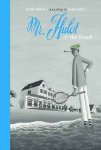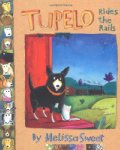There is something incredibly soothing about reading poetry. As it is not prose, the form of writing we are most used to, we tend to take our time with poetry, slowing down our reading so that we can take in the words. Of late the news has been full of awfulness of the worst kind and I have found myself taking refuge from the headlines by reading novels that are written in verse. For a while at least I get a break from violence, anger, frustration, and loss. For children, perhaps today's poetry book will offer a similar little break from the tension that is rippling through our world.
 The Frogs Wore Red Suspenders
The Frogs Wore Red Suspenders
 The Frogs Wore Red Suspenders
The Frogs Wore Red Suspenders
Jack Prelutsky
Illustrated by Petra Mathers
Poetry Picture Book
For ages 4 to 6
HarperCollins, 2005, 978-0060737764
One of the best ways to help children engage with poetry
is to create poems that make them laugh, or poems that engage the imagination.
Jack Prelutsky is a master when it comes to writing poems that contain just the
right amount of delightfully silly fun to keep children coming back for more.
He also paints pictures with his words to such great effect that children are also
drawn to his gentler, more lyrical poems as well.
In this poetry
collection, animal and human characters do all kinds of delightful things, the
kinds of things that children will enjoy reading about. We begin with a quintet
of frogs (wearing red shorts with red suspenders) and a quartet of pigs (in
purple vests) who are on a stage. They are singing to an audience of chickens
and ducks, all of whom are sitting “upon their nests.” One would think that the
noise would scare the birds away, but they are delighted by the croaky and
oinky “serenade.” So much so in fact that they “laid enormous spangled eggs /
and quacked and clucked with pride.”
In I went to a store we meet a fellow who
goes to a store where the storekeepers don’t have any of the things he wants. Instead,
they sell him things that he really does not need at all. For example, instead
of selling him a pear and a plum they sell him a drum, and instead of some
cheese he ends up with a lamp. Clearly this is the kind of store that he should
avoid in future!
Then there is
Sarah Small who grows all kinds of clothing in her garden. There are galoshes
“short and tall,” as well as “Shirts of yellow, hats of red.” If you need
pajamas, sweaters, ties, or mittens, shoes or stockings, this is the place to
come, for Sarah Small has them all.
This is a book
where there is something for everyone, and for every mood. Readers will enjoy
dipping into to this poetry collection, and they will come back to it again and
again.








